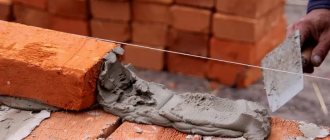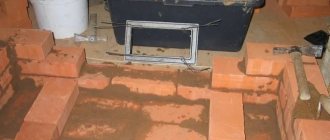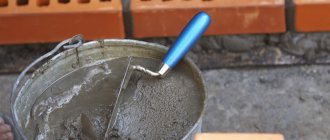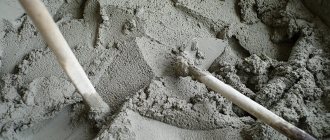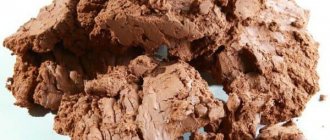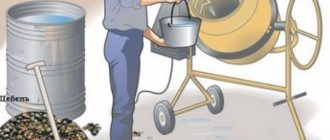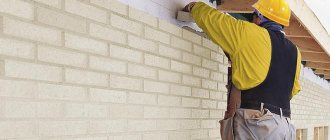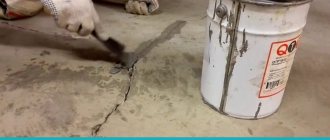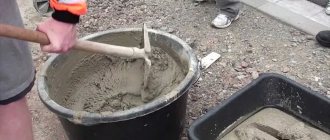Comments:
Rating: 34
Heat-resistant concrete is a type of concrete that is used under conditions of long-term exposure to high temperatures and is able to retain its mechanical properties. It is used in industry in the construction of thermal units, foundations of blast furnaces, recycling furnaces, brick firing.
Characteristics of concrete.
In small enterprises and private construction, heat-resistant concrete is used to construct prefabricated block heating stoves, fireplaces, stoves in baths and saunas, and chimneys.
Due to its low thermal conductivity, ordinary concrete is able to withstand short-term heating up to a temperature of 200°C, but when the temperature rises to 200°C - 250°C, it loses up to 25% of its strength, and at temperatures above 250°C it begins to crack, bonds with reinforcement and it is completely destroyed.
The main reason is that at high temperatures it dehydrates and decomposes its components.
Due to moisture and sudden temperature changes when extinguishing fires, ordinary concrete breaks down even faster.
Heat-resistant concrete can be used at temperatures not exceeding 1580°C, refractory concrete - up to 1770°C, highly refractory concrete - above 770°C. The main binding materials for their production are Portland slag cement, Portland cement, phosphate additives, orthophosphoric acid, and liquid glass.
To give it such properties, refractory rocks and refractory crushed aggregates (crushed products made from refractory materials) are added to the mixture. Heat-resistant concrete becomes more durable during operation.
Types of refractory aluminas
For different operating conditions, heat-resistant cement is produced in several types. The packaging is marked with the following symbols:
- GC. Aluminous cement, capable of setting and gaining grade strength in air and water (without access to oxygen). Material with a high content of Al₂O₃ (aluminum oxide). The powder has a shade from dark brown to gray-green.
- GC40 – GC60. These compounds are used in the fuel, energy, industrial and road construction sectors. Widely used in the creation of special mortars and dry heat-resistant mixtures, monoliths. Indispensable for concreting at low temperatures.
- VGTs 70 – VGTs 75, VGTSI – VGTsIII. Designation of high-alumina grades with enhanced characteristics. They do not “gas” when heated strongly. Intended for the production of construction quick-hardening concrete or mortar. In relation to GC, their cost is higher.
VGKTs-70-1 is used in ferrous and non-ferrous metallurgy, oil refining, chemical industries, production of refractories, lining of firing furnaces (glass, cement, ceramics). It is used to make stones and substrates due to its combination of heat resistance and strength.
How to prepare fireproof material yourself?
Heat-resistant properties in private construction will be required for cement for the stove, chimneys, base and firebox. It can be chosen as an additive during concreting if the air temperature at the work site has dropped to -10°C. The fireproof characteristics of PC-based concrete can be enhanced by including asbestos powder, liquid glass, alumina, periclase or barium binder in its recipe.
Mixing of the composition with the inclusion of liquid glass is carried out with the addition of granulated blast furnace slag, sodium silicofluoride, and nepheline sludge. With the participation of periclase material, an aqueous solution of magnesium sulfate must be used.
In addition to special cements, it is advisable to use a certain filler. It imparts rigidity to the frozen mass, is a heat insulator and retains its shape, having a low coefficient of expansion, in the area of high temperatures.
At home, you can buy and add the following types of fireproof fillers, differing in particle size:
- expanded clay;
- broken fireclay bricks;
- lump fireclay;
- fly ash;
- vermiculite;
- granulated blast furnace slag;
- broken magnesite brick;
- Cemyanka;
- perlite;
- pumice;
- andesite;
- chromite ore;
- loess loam;
- break of diatomaceous brick.
The components are mixed in proportions 3:2:2:0.5, where gravel is 3 parts, 2 refractory binders, 2 sand, 0.5 slaked lime. The amount of prepared composition should not affect the ratio of ingredients in the recipe. Portland cement can be used for work on areas of chimneys, supporting and decorative structures that are remote from the combustion zone and where there are significant temperature changes.
It will be cheaper to buy a high-quality fire-resistant dry mix in winter than in summer. But in any case, it must have a manufacturer’s certificate.
| Brand | Manufacturer country) | Quantity, kg | Price, rubles |
| GORKAL 40 | Poland | 50 | 1300 |
| GC-40 | Ukraine | 50 | 1300 |
| ISIDAS 40 | Türkiye | 25 | 625 |
| LAKKA TULENKESTAVA | Finland | 25 | 1300 |
| VGTs-50 | Novosibirsk, Russia) | 20 | 1800 |
| GC-40 | Russia (LLC Construction Materials Plant) | 1000 | 23040 |
| GC-40 | Russia (Pashinsky PMCP) | 50 | 37/1 kg |
| VGTs-2-25 | Russia (Ogneuporkomplekt LLC) | 1 | 99 |
| VGMC-I-1700 | Russia (TECHNOCENTER LLC) | 1 | 127 |
| VGC-2 | Russia (Own production) | 50 | 3900 |
Do-it-yourself heat-resistant concrete based on alumina cement
Making cinder blocks with your own hands: instructions for making them at home
To make fire-resistant concrete on a base at home, you need to prepare the following components:
- Water.
- Binding and heat-resistant additives.
The technological process contains a lot of nuances. First of all, you should take care of the cleanliness of all components, and also prevent the possibility of contamination of refractory components with sand, granite or limestone.
Experts recommend choosing the first option, since ready-made dry mixtures have the required performance characteristics and are produced using a factory process. Therefore, the user is provided with premium quality cement, which only needs to be diluted with water or solvent.
When starting to make your own mixture, it is important to provide for the following additives:
- Chromite ore.
- Magnesite cement.
- Andesite.
- Fireclay fight.
If you choose the right ingredients, the final design will be reliable and durable.
All components are transferred to a concrete mixer and thoroughly mixed in a ratio of 1:4 (cement and sand). When you get a homogeneous mixture, you can add liquid to it until a dough-like consistency appears. In this case, the mixture will receive the required degree of viscosity and quickly become solid.
When diluting it with water, it is important to adhere to the recommendations of specialists and not deviate from the recipe
The finished composition is placed in molds and poured into formwork or used for brickwork
When using aluminous fillers, it is important to dilute them with water in time to prevent excessively rapid setting. After completing all actions, it is necessary to clean the equipment and get rid of the frozen material with the tool
If you want to make a small amount of Portland cement-based mortar, mixing the components can be done without a concrete mixer. Wide containers and hand tools are used for this purpose.
After completing all the steps, it is necessary to clean the equipment and get rid of the frozen material with the tool. If you want to make a small amount of Portland cement-based mortar, mixing the components can be done without a concrete mixer. For this purpose, wide containers and hand tools are used.
Features of preparing working solutions
Regardless of the chosen composition of the refractory mixture, the master will need water in any case.
It should not contain large amounts of hardness salts - calcium and magnesium bicarbonates. Usually, the population knows the characteristics of local water, the location of sources with water of low hardness. If necessary, you can slightly soften the water using special methods, but it is advisable to do this only as a last resort, since the pleasure will be quite expensive.
For do-it-yourself masonry of all parts of the furnace, white sand with a quartz composition is ideal. Yellowish sand grains can be used for laying any parts of the stove structure, except for the combustion chamber.
There are long-standing historical methods for determining the amount of sand to add to clay. The ancestors lived a leisurely, measured life, so the mixtures were tested for more than 3 weeks. Now people do the test faster - they prepare several versions of cakes or balls, wait for them to dry completely, then drop them onto a wooden surface from a height of one meter. The composition that did not split is worthy of attention. If there are several such resistant samples, the height for testing can be increased, ultimately choosing the most durable option.
The final control check can be carried out as follows: smear the wide part of the brick (bed) with the prepared mixture with a layer of mortar of at least 3 mm, lay the second brick on top, press it well by tapping it with a wooden handle, wait 10 minutes and lift it. If the bottom brick is held and does not fall, the compound is suitable.
Advantages
Making molds for concrete casting
Refractory grades of cement have the following advantages:
- ability to withstand open fire;
- resistance to short-term heating above 3000 ℃;
- high mechanical strength;
- increased adhesion compared to all other types of mixtures;
- high speed of complete solidification of the mass;
- inertia in relation to the aggressive influence of the external environment.
Heat-resistant cement is finely ground, after which the homogeneous powder is sifted through sieve No. 008, obtaining 90% of the material. The fraction with larger grains is no more than 10%. Cement mixture with normal alumina content is colored gray or light brown; with an increased concentration of a heat-resistant component - in white or light steel colors. The density of the refractory powder is different: its minimum is 2.8 g/cm2, the maximum is 3.2 g/cm2.
A product with improved refractory properties is prepared using standard technology, using the usual amount of sand and water. In this case, you have to wait from 1 to 3 days for Portland cement to harden, while fire-resistant grades harden completely in 10 hours, even in a humid environment.
Among the negative aspects characterizing heat-resistant cement, they note an increased price compared to other varieties, which is quite understandable. Some authors talk about the harmful effects of alkalis on refractory materials. It is possible that concentrated alkalis under some conditions can react with a certain part of the refractory raw material, but in practice, alkaline effects of this kind cannot occur under any circumstances.
Mortar mixtures
One of the most popular mixtures for stoves is mortar. It comes in the form of a very fine powder. For use, the powder is diluted with water and used for masonry in tandem with refractory bricks or stone.
Not every mortar mixture is suitable for laying a hearth. There are fire-resistant and conventional hardening mixtures. The latter become hard during heat treatment, like ceramics. They contain hydraulic cement.
Mixtures without hydraulic inclusions with other additives are called fire-resistant. There are different types of mortar, differing in grain size. So, fine-grained mixtures are called mixtures with particles up to 1 mm, and large-grained - up to 2.
Different markings of the solution are designated by the letter abbreviations MS. The material is most often used for home or commercial stoves; for industrial fireplaces, an alax mixture is used. The finished shell from the mortar mixture has very high strength and can be used for many years without problems.
Developments for critical temperature conditions
Wooden grape press. how to make a grape press with your own hands: device, choice of material and step-by-step manufacturing process. making your own wine juicer
In practice, conventional concrete mixtures do not tolerate high temperatures well. Even those options that are considered one of the highest quality and most expensive cannot guarantee safety at temperatures exceeding 150 degrees. The material begins to crumble and lose shape, as a result of which the entire structure suffers.
That is why experts have developed special compositions that retain properties at elevated temperatures. Today, there are so-called highly refractory concretes, used in conditions where temperatures exceed 1770 degrees, fireproof options that work with temperatures from 1580 to 1770 degrees, and heat-resistant ones, their limit is 1580 degrees.
Any heat-resistant concrete consists of a base and a filler; in the manufacture of such material, specific elements are used: liquid glass, aluminum cement, expanded clay, etc.
Concrete work in dry and hot climates
In a hot, dry climate, the air temperature can rise to +40C, humidity usually does not exceed 25%, there are winds and strong solar activity. All this has a bad effect on the concrete mixture, causing rapid evaporation of water and a decrease in strength.
- Choose the right composition of components - it is best to use Portland cement as a binder, and fillers - materials with an identical thermal expansion index (close to cement).
- Fillers must be moisturized.
- The use of plasticizers is to reduce the water-cement ratio and improve mobility.
- Increase in mixing time of components by an average of 40-50%.
- The mixture can be transported to the site exclusively in a concrete mixer, loading only dry components into the mixer, and mixing with water before pouring.
- Before pouring, the formwork is checked for tightness and moistened.
- The mixture is supplied to the site using a special bucket or concrete pump.
- Concreting is carried out using a deep vibrator.
- In the process of gaining strength with the mixture, the concrete must be covered with moistened straw mats, pieces of matting, burlap, and then watered with water every 3-4 hours for the entire 28 days.
Heat-resistant or refractory concrete prepared according to all the rules will demonstrate all the declared characteristics and will allow the implementation of any project, guaranteeing high quality and optimal properties, reliability and durability of the structure.
Source
DETERMINATION OF LIQUID GLASS MODULE BY ACCELERATED METHOD
The average sample for analysis is taken from the upper settled layer of liquid glass without stirring, after first removing the surface film, then proceed to determine the content of sodium oxide in it. To do this, liquid glass is diluted with water to a density of 1.38 g/cm3. Then a sample of liquid glass weighing about 1 g is washed off with hot distilled water into a beaker with a volume of 250-300 ml, mixed thoroughly, covered with a watch glass and boiled for 10 minutes.
After cooling, add 3-4 drops of 0.2% methyl orange solution to the solution and titrate with 0.1 normal HCl solution until the color of the liquid changes from yellow to pale pink.
The modulus of liquid glass is determined by the formula
Msg = 162dι- 2.5,
where d is a sample of liquid glass, ι is the volume of 0.1 HCl solution consumed during titration, ml; 162 and 2.5 are empirical coefficients.
CHECKING THE QUALITY OF THE HARDENER
To check the quality of the hardener (except for sodium silicofluoride), a sample of about 5 kg is taken from each batch from several places, but not less than three, and reduced to 0.5-1 kg using the quartering method. Next, the material is dried to constant weight at a temperature of 100-110 ° C and the grinding fineness and chemical composition are determined. To control the grinding fineness, take a sample of the material weighing 100 g and sift it through sieve No. 008. The chemical composition of all hardeners (except sodium silicofluoride) is determined according to GOST 2642.0-86.
To check the quality of the hardener - sodium silicofluoride, an average sample is taken, dried to a constant weight at a temperature of 100-110 ° C and crushed in a mortar.
A sample of the material weighing about 1 g is dissolved in 100 ml of hot water, free of carbon dioxide, and titrated with a 0.5 normal NaOH solution containing two to three drops of phenolphthalein until a faint pink color appears. The solution is then heated to boiling and titrated again until the color no longer discolors. A slight pink color upon boiling indicates the end of the titration. The percentage of sodium silicofluoride in a technical product is calculated using the approximate formula
m = 0.0235/K V 100,
where 0.0235 is the amount of Na2SiF6 corresponding to 1 ml of 0.5 normal NaOH solution; V
— volume of 0.5 N NaOH solution used for titration, ml;
K
- weighed portion of technical sodium silicofluoride, g.
To determine the activity of hardeners, mix 200 g of finely ground chamotte and 100 g of a hardener (nepheline sludge, self-disintegrating slag, phosphorus slag) or 30 g of a hardener (sodium silicofluoride), mix with liquid glass until a dough of normal thickness is obtained, a cake is made from the resulting mixture, which is immediately wrapped in plastic wrap. After keeping the cake in the film at a temperature not lower than 20 ° C for 24 hours, it is removed and broken.
A high-quality hardener ensures good hardening and strength of the cake over its entire cross-section.
Main characteristics
Concrete refractories are divided into several groups according to their parameters, the materials of each of them differ in their technical parameters:
- Heat resistant. Concrete stably withstands heating up to +700 degrees C, and short-term excesses up to 1500 degrees C. For mixing, slag-portlant cements or Portland cements are used.
- Refractory. The material is intended for the construction of objects that heat up to +1000 degrees C. A temporary increase is possible - up to 1800 degrees C. Liquid glass and alumina components are often added to them for resistance to corrosion processes.
- Highly fire-resistant. This refractory will be required for facilities that operate at extremely high temperatures - over 1800 degrees C. Crushed fireclay bricks, Portland cements, diatomaceous earth, alumina and other components are added to them.
Main settings
Classification of refractory concrete
Fire-resistant concrete is classified according to various criteria:
- maximum operating temperature;
- purpose of the material;
- type of filler;
- type of binder component.
Scope of application
The scope of use of the material is not limited to the manufacture of thermally resistant structures: combustion chambers, home or industrial furnaces, collectors and foundations. Due to the inclusion of specific ingredients in the composition, the material is widely used in the production of building materials, the chemical industry, and the energy sector.
Heat-resistant concrete is also used for the construction of floating structures, floors, bridges - in structures that require high strength of the material with low weight. The relatively small mass of concrete is due to the addition of porous fillers.
Classification
There are several types of heat-resistant concrete, which is also called fire-resistant or heat-resistant.
The material contains special fire-resistant additives. The main binding component in the production of heat-resistant concrete is Portland cement. The following can be used as fillers: blast furnace slag, rock screenings (diabase, andesite, porous rocks of volcanic origin, diorite, artificial fillers), blast furnace slag.
The material is divided into separate classes according to:
- Structure (heavy, light, porous). Purpose (thermal insulation, structural). The nature of the fillers. The binder components used.
Heavy heat-resistant concrete: application and composition
Heavy heat-resistant mixtures are in demand for lining units operated at high temperatures, at chemical industry enterprises, and during the construction of chimneys. The specific area of application is determined by the components of the mixture.
Portland cement and Portland slag cement with microadditives
This material is stable in neutral and alkali-containing environments. This is the most popular group of heat-resistant concretes. The popularity is explained by the relatively low cost of raw materials, proven manufacturing technology, and good performance characteristics of the finished product. Such concrete mixtures are in demand in the construction of heating units, pipes of nuclear power plants and other objects operated at elevated temperatures.
Table of compositions of heat-resistant concrete based on Portland cement and Portland slag cement
| Material consumption, t/m3 | Finely ground additive | Fillers | Maximum operating temperature, °C | |||
| Cement | Finely ground additive | Fillers | ||||
| Small | Large | |||||
| 0,35 | 0,12 | 0,5-0,9 | 0,6-1,0 | Fly ash, pumice, clay brick, granulated blast furnace slag | Andesite, basalt, diorite, diabase, tuff, blast furnace slag | 700 |
| 0,35 | 0,12 | 0,5 | 0,6 | Fuel slag | Fuel slag | 800 |
| 0,35 | 0,12 | 0,5 | 0,6 | Clay brick fight | Clay brick fight | 900 |
| 0,35 | 0,12 | 0,65 | 0,6 | Fly ash, fireclay class B | Fireclay class B | 1000-1100 |
| 0,35 | 0,7 | 0,65 | 0,65-0,75 | Fireclay class B | Fireclay class B | 1100-1200 |
Material with finely ground fireclay components has the highest strength characteristics.
Aluminate, alumina and high alumina cement
Mixtures based on them are used in carbon, hydrogen and phosphorus environments. Heat resistance classes – I8-18. Heat-resistant structures based on aluminate cement are resistant to temperatures up to +1300°C without special additives, and up to +1700°C with additives.
Structures made from alumina and high-alumina heat-resistant concrete are characterized by:
- good mechanical properties;
- stability of characteristics under sudden temperature changes;
- low thermal shrinkage;
- small linear expansion;
- low thermal conductivity coefficient.
Liquid glass
Demanded for concrete mixtures resistant to acidic gaseous media. For the production of fire-resistant concrete intended for operation at temperatures of +800...+1600°C, potassium or soda glass is used.
| Maximum application temperature, °C, permissible with one-sided heating | Finely ground additive | Fine and coarse aggregates | Composition, t/m3 | |||
| Liquid glass | Mineral supplement | Sand | Crushed stone | |||
| +1400 | Magnesite | Broken magnesite brick | 0,35 | 0,6 | 0,6 | 1,15 |
| +1000 | Chromite | Chromite | 0,3 | 0,7 | 0,8 | 1,25 |
| +900 | Chamotte | Chamotte | 0,4 | 0,5 | 0,5 | 0,75 |
| +600 | Chamotte, andesite, diabase | Diabase, andesite, basalt | 0,35 | 0,5 | 0,7 | 0,9 |
Hardening of silicate mixtures is a slow process. To increase its intensity, sodium silicofluoride and alkali metal fluorosilicates are added to the composition. These hardeners initiate the release of silicic acid, which helps compact and strengthen the concrete. The following can accelerate the hardening of a concrete mixture: nepheline sludge, ferromanganese and ferrochrome slags.
This is interesting: Characteristics of heat-resistant concrete - consider carefully
Popular brands
When purchasing a plaster composition, it is important to pay attention to the following:
- permissible operating temperature limit;
- whether the composition is intended for indoor or outdoor work;
- environmental friendliness of components;
- hardening time;
- resistance to moisture, sudden heating or cooling.
The integrity of the packaging, date of manufacture, and compliance with storage conditions are important.
Heat-resistant plaster for stoves and fireplaces
The following types of brands are the most popular.
PECHFORM PC400 W
Heat-resistant variety. Suitable for lining the flood zone, areas near the hob, side walls of the stove, fireplace.
The maximum permissible operating temperature is 400 degrees. There is no need to additionally putty the surface on top.
Can be used for outdoor and indoor work.
Surface material for application:
- brickwork;
- concrete;
- limestone;
- composite slabs.
5 minutes after mixing the solution it is ready for use and remains suitable for application after 2 hours. Do not apply on top of metal parts.
During operation and drying of the composition, the temperature should be from +5 to +30 degrees. Painting is allowed after 2 weeks.
Typhoon Master
Products from a domestic manufacturer. Heat-resistant plaster is used for finishing walls, chimneys of fireplaces, barbecues and barbecues made of brick.
Has the following properties:
- heat resistance;
- tolerates moisture well;
- plastic;
- convenient for vertical application.
The average mixture consumption per 1 square meter is from 1.6 to 1.8 kg.
Kalina Master
Fireproof plaster. Contains Portland cement. It is characterized by increased strength. Excellent resistance to high temperatures. Quickly sets to the surface. Resistant to mechanical damage.
Pechnik
The base is fireclay clay. Suitable for masonry and finishing of stoves. Hardens quickly. It is used in working with old and new furnaces. Convenient to apply.
It does not collapse when the product shrinks, it is plastic.
Heat-resistant adhesives
Act as a connecting substance for fastening tiles to the surface of a stove or fireplace.
Two types are in greatest demand.
Terracotta
Sold dry. The main raw material is refractory kaolin clay. Does not lose properties at +400 degrees (permissible limit).
It is distinguished by its plasticity, ease of installation, and good adhesion. Used for leveling walls and plastering. All components of the composition are environmentally friendly. It hardens quickly, within an hour after mixing.
The recommended layer thickness is up to 1 cm.
Hercules
Heat-resistant glue. Used for laying fireplaces, stoves, barbecue complexes made of refractory bricks. Suitable for fixing tiles.
Packaged in bags of 5, 12 and 25 kg.
Operating temperature range from –50 to +1200 degrees.
Composition and characteristics
Classification of concrete is carried out according to GOST 25192-2012.
- The most common types are the following:
- heavy structural;
- light and cellular;
- hydraulic engineering;
- road;
- heat resistant;
- acid-resistant.
Structural ones are used in the manufacture of columns, walls, beams and trusses, and floor slabs. They are made on the basis of a cement binder with the addition of a large amount of high-strength coarse aggregate, sand and special additives that improve the properties of the concrete mixture.
Lightweight cellular materials are used for the manufacture of enclosing structures in frame buildings. In low-rise buildings, walls and columns can be constructed from this material. Light cellular concrete includes aerated concrete and foam concrete. They can only be manufactured in production and delivered to the place of use in the form of block forms. Lightweight concrete products also include expanded clay concrete blocks, in which expanded clay crushed stone is used as a coarse aggregate.
Hydraulic concrete is used for the construction of structures or some of their structures that are constantly or periodically in contact with water - dams, dams, swimming pools, wastewater treatment plants. Such materials must have a high density, ensuring water resistance and good frost-resistant properties. Special plasticizers are introduced into the composition to facilitate compaction of the mixture and eliminate the appearance of numerous pores.
Road concrete is used to make pavements for highways and airfields. Such materials must be durable and also must withstand the effects of a large number of freezing and thawing cycles. In addition, they must be resistant to various oils and other aggressive liquids.
Acid-resistant ones are used, as the name implies, for structures operating under the influence of acidic environments. They are made from quartz sand, soluble glass, and acid-resistant filler.
Separation by composition
The composition of refractory concrete differs from conventional concrete in its high concentration of porous and finely dispersed substances. They ensure the process of concrete hydration, preventing its dehydration.
Binders are a dispersion system of fine-grained cement and a chemical binder.
Silicate type of concrete
Depending on the type of binder, there are:
- hydration concrete, hardening by adding water to refractory cement;
- silicate - in them the binder is not water, but silicic acid compounds with alkaline additives;
- phosphate, in which aqueous solutions of orthophosphoric acid salts are used for binding;
- sulfate-chloride - a mixture of magnesium cements and Mg, Fe, Al salts;
- organic, where resins or their distillation products act as binders.
To improve the characteristics of refractory concrete, reinforcing additives from glass, asbestos, and steel are introduced into its composition. Ready-made dry mixtures containing all the necessary components are available on the market.
Factory-made masonry mixtures for laying stoves
We are talking about fireproof dry powders, which, after dissolving in water, turn into a homogeneous mass. The cooking recipe is usually indicated in the accompanying instructions. Along with the usual components (sand and cement), the solution contains special heat-resistant additives.
The refractory mixture for laying furnaces produced at the enterprise has a number of advantages:
- Well-calibrated composition. Under production conditions, careful dosage of each component is carried out, according to time-tested recipes and proportions.
- Specific additives. The components that give refractory mixtures their “proprietary” characteristics are often not commercially available (and sometimes even kept secret).
- Versatility. As a rule, industrial solutions are multifunctional: they can be used to lay stoves and then plaster finished walls.
- External aesthetics. Although a finishing finish is still applied over masonry or plaster, it is much more pleasant to work with an attractive-looking mortar.
Our stove makers especially liked the products of such manufacturers of masonry mixtures for stoves and fireplaces: “PLITONIT”, “TERRACOT”, “Makarov Stove House”, “Pechnik”, “Scanex”, “SPO”. As for the disadvantages of this type of material, it is usually called their high cost. In cases where it is necessary to save money, they try to use self-prepared heat-resistant solutions.
Working with mixture and fireclay bricks
Mixtures for laying fireproof stoves must be made with high quality
But it is equally important to do their proper installation.
Particular attention must be paid when filling the seams with mortar. If the filling is poor, water may get into the seams, and if it freezes, the masonry will crumble much earlier than planned.
The choice of brick laying category depends directly on the future temperature condition. The higher the temperature, the smaller the seam should be:
- 1 mm – first category;
- 2 mm – second category;
- 3 mm – third category;
- more than 3 mm – fourth category.
To determine the quality of the seam, I use a special probe with a width of 15 mm, and the thickness must be equal to the seam.
- The probe must penetrate 20 mm into the seam. To ensure that the bricks are positioned correctly, they are tapped with the handle of a trowel. To ensure that the seams are of a certain horizontalness, ordering slats are used and a cord is attached to them. After the first layer, the laying is determined only by this cord.
- The characteristics and reliability of masonry largely depend on the uniform application of the mortar to the surface.
Note: The brick sucks moisture out of the mixture, preventing it from drying out. Therefore, the brick is periodically wetted during the laying process, or even pre-soaked beforehand.
The fireproof mixture will help you make a quality structure, but you should never rush. You should look at photos and videos to understand the entire cooking process. After all, construction requires high-quality materials.
This is interesting: How to choose a set of drills: we explain the question
Main types of heavy fire-resistant concrete
The composition of refractory concrete can be different, depending on the desired characteristics, the materials used and their proportions. There are several types of heavy concrete, the main ones are discussed below.
Concrete based on Portland cement and Portland slag cement
This is the most common type of heat-resistant concrete, characterized by low cost, proven technology of preparation and use, and good strength. Typically, such concrete is chosen for the construction of chimneys, thermal units, creating fire-resistant structures for nuclear power plants, etc.
The strength class should be in the range B15-B40. Cement M400 and higher is used in the preparation; only active minerals are added (fuel ash, fireclay, blast furnace slag, etc.). The most durable concrete is obtained with the inclusion of finely ground fireclay additives in the composition.
Portland slag cement technology provides for the addition of metallurgical blast furnace slag, so the mixture can be used for mixing concrete with expected exposure to temperatures not exceeding +700C.
On alumina aluminate cement
Concrete with a heat resistance class in the range I8-I18 is prepared from these substances. The main mineral component of such cement is calcium monoaluminate, and high-alumina cement is calcium dialuminate. If you do not add any additional additives to the composition, the concrete will withstand a maximum of +1300C; if you include corundum and aluminum oxide filler, you can increase the temperature to +1650C or more.
Main properties of structures made from aluminous cements:
- Minimal thermal shrinkage, slight linear expansion during heating
- High mechanical strength
- Maintaining a stable state during sudden temperature changes
- Thermal conductivity is minimal
- Within a day after pouring, the structures can be used
Liquid glass as a binder for heat-resistant concrete
Before preparing heat-resistant concrete from liquid glass, it is necessary to carefully study the composition of the mixture. Potassium/sodium compounds are used, thanks to which refractory concrete can be used at temperatures of +800-1600C.
In terms of structure, liquid glass can be high-modulus (indicated by the letter B), medium-modulus (B) and low-modulus (letter A).
What is important to know about liquid glass:
- The best performance of soda glass as a binder for a refractory mixture is with a silicate module of 2.0-3.5, potassium - 2.5-4.0.
- Liquid glass hardens for a long time, so various hardeners are added to the mixture (sodium silicon fluoride compound, alkali metal fluorosilicate). In addition to rapid hardening, these substances help increase the strength and density of the solution. You can also add ferrochrome, ferromanganese slag, and nepheline sludge to accelerate hardening.
- It is worth noting that various plasticizers, finely ground additives, regulators, and additives can be added to the mixtures for better workability.
- Per cubic meter of concrete you need approximately 250-400 kg/m3 of binder, hardener - 0.1-0.2 parts of the weight of the binder. The filler will need about 0.12-0.3 the weight of liquid glass.
- The solution based on liquid glass is mixed on site, since the mixture must be poured within half an hour. Laying is carried out at a temperature of at least +15C, humidity should be a maximum of 70%.
Options for mortars for laying stoves
Today, various modifications of masonry mortars are used, among them the following are popular:
- heat-resistant mixture, which is intended for outdoor use. Such solutions are used for masonry and plastering of barbecues, barbecues, smokehouses, stoves, which are used only in the open air;
- mortar for laying household, industrial stoves, fireplaces made of fireclay refractory bricks. The operating temperature of such structures can be up to 1750 degrees;
- a special masonry mixture designed for working with red brick. Using this solution, fireplaces are laid. household stoves, heater stoves, the operating temperature for which is up to 850 degrees;
- A special masonry mixture is used for fastening tiles and plastering the surface of fireplaces, chimneys and stoves.
The masonry mortar has the following characteristics:
You need to add lime paste to a thin solution, and sand to a fat solution.
- the appearance must be uniform and free from foreign impurities;
- moisture content of the composition - no more than half a percent;
- maximum grain size - up to 2.5 mm;
- bulk density - 1500 kg per cubic m;
- ready-made masonry mortar can be used for three hours;
- the water-holding capacity of the resulting solution is 95 percent;
- compressive strength - two Mega Pascals;
- loss of mixture mass during calcination - up to 5 percent.
The special composition that is used for filling and repairing the hearth inside the furnace has the following characteristics:
- the minimum temperature for work is five degrees Celsius;
- time to use the ready-made solution is one hour;
- maximum grain size - 5 mm;
- water consumption for preparing 25 kg of mixture is 2.5-3.5 liters, finished mass is 11-12 liters per 25 kg;
- heat resistance - 1300 degrees.
Making heat-resistant concrete based on alumina cement
The exact proportions of material consumption for preparing the concrete mixture are determined by the work project or by construction laboratory specialists. But the typical composition for the production of 1 m3 of heat-resistant concrete is as follows:
- aluminous cement – 300 kg;
- chromite or fireclay crushed stone – 1200 kg;
- chromite or fireclay sand – 750 kg;
- water - approximately 170 l.
The concrete mixture should be prepared in such portions that it can be processed in a short time. To do this, we use a mobile concrete mixer, or improvised means: a trough or bunker, a construction mixer or a hammer drill with an attachment in the form of a mixer. As a last resort, you can mix the composition with a bayonet shovel.
First, load the calculated amount of dry ingredients into the container or drum of the concrete mixer and mix them. Without ceasing to stir, gradually add water in the amount needed to obtain the mixture of the desired plasticity.
From the resulting composition, you can make blocks for the construction of a stove or fireplace, for which we move it into a previously prepared equipment, compact it, and level the upper surface. Cover the molded products with film and leave for two to three days, periodically sprinkling them with water. We store the finished blocks on racks in a ventilated area and store them until fully ripe for 20-25 days.
Scope of application
The production of refractory concrete began during the emergence of blast furnaces. They were used for lining air heaters and the front walls of open hearths.
Their production was carried out mainly at metallurgical enterprises, but over time it became a separate industry with a wide scope of application.
Application of refractory concrete in metallurgy
The advantages of the material are:
- availability of constituent components;
- high thermal insulation properties;
- resistance to sudden temperature changes;
- enhancing strength characteristics during operation;
- no need for firing after pouring.
Products made from refractory concrete are used in all areas where high temperature loads are possible:
- when creating load-bearing structures for industrial furnaces at metallurgical plants;
- in organic synthesis processes during hydrocarbon processing;
- brick kilns;
- in the construction of fireplaces and hearths in private cottages;
- for internal lining of boilers;
- thermal insulation of objects under construction;
- construction of floating structures that require low weight but high strength.
This is interesting: Voluntary fire department - tasks and creation procedure
Materials and tools
To produce refractory concrete blocks, you will need to prepare the following tools:
- wheelbarrow;
- concrete mixer;
- hose;
- formwork;
- Master OK;
- vibrating tools (for example, a hammer drill);
- spray;
- sheet of plastic;
- refractory cement;
- slaked lime;
- gravel.
It is also not superfluous to use additives:
- asbestos;
- barium cement;
- liquid glass.
These additives will give concrete all the necessary characteristics that allow it to be used in the construction of structures that will be operated at high temperatures.
Heat-resistant concrete is made by hand as follows:
- Cement and sand are poured into a concrete mixer in a ratio of 1:4.
- While stirring, water (preferably filtered) and finely ground ingredients are gradually poured into the mixture until a dough-like consistency is obtained.
Healthy! To improve the result, it is recommended to use ingredients at room temperature - 15-20 ° C.
Pouring the mixture
The prepared concrete mixture must be poured into formwork or molds pre-lubricated with grease or silicone to prevent moisture loss and simplify removal of the frozen block.
The work must be done quickly, since the solution is highly dense and hardens quickly. The solution is laid with a shovel with a small reserve, and the excess is removed with a trowel.
Seal
The concrete mixture is compacted using various tamping mechanisms: submersible or surface vibrators. The working part of the tool is placed in a mold filled with the mixture and the solution shrinks within a minute.
The main purpose of compaction is to eliminate air bubbles that negatively affect the characteristics of the material, as well as reducing its quality and performance properties.
Exposure and hydration
Once compaction is complete, the mortar is left to harden. During natural hardening, moisture evaporates from the mixture, which can lead to cracking of the blocks. Therefore, the solution must be periodically moistened by spraying it with water.
During the first 48 hours, the hardening blocks are covered with plastic film. After two days, the film is removed, the blocks are removed from the molds and transferred to a warm room for 28 days, which is required for the final strength gain.
At the final stage of manufacturing the material, you should wash the equipment used and remove any remaining mixture from it. It is better to clean tools immediately after using them to prevent the cement mortar from drying out.
Goals
If you plan to use water in everyday life, especially for drinking and cooking, cleaning it from clay is necessary. It allows:
- reduce turbidity - even in small concentrations, clay suspension reduces the transparency of water and makes it unsuitable for drinking;
- soften water and remove impurities from it - water containing dissolved clay, in terms of hardness, as a rule, does not meet the requirements of GOST “Drinking Water”, and is also often unsuitable for domestic needs;
- eliminate odor - drinking water, according to regulatory documents, should not have any foreign odors.
- disinfect water at the initial stage of purification, since clay suspension often contains dangerous microorganisms, algae, protozoa and other biological objects.

